Fun-tastic railway trips on JR Kyushu’s D&S Trains: Mountainside edition
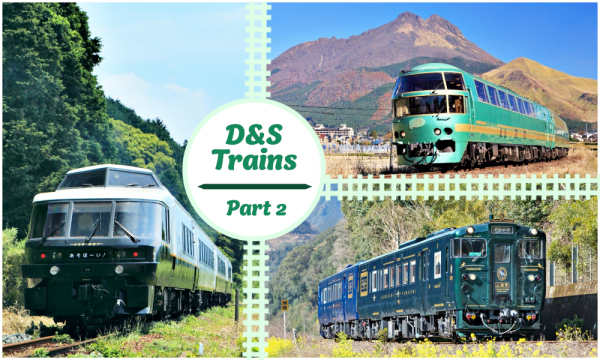
The island of Kyushu is home to majestic volcanic mountains and enchanting natural scenery, and what better way to explore the island than by rail? JR Kyushu’s sightseeing trains, known as Design & Story Trains (D&S Trains), are full of character, with distinctive and elegant designs, and packed with unique features that allow passengers to enjoy Kyushu's stunning landscape and passing scenery. As the name suggests, each D&S Train has its own unique design and story behind it, and aims to brings passengers on fun-filled and memorable journeys around Kyushu.
Trains introduced in this series. (Image credit: Carissa Loh)
In case you missed it, we introduced three D&S Trains traversing seaside routes in the previous article, which you can check out here. In this article, we will take a look at three other D&S Trains plying mountain and highland routes, the interesting stories behind them, and some of the amazing scenery and sightseeing spots you can enjoy. Are you ready to for a fun-tastic railway journey? Let’s go~
④ YUFUIN NO MORI: The pioneer D&S Train
Route: Hakata Station (博多駅) ↔ Yufuin Station (由布院駅)・Beppu Station (別府駅) on the Kyūdai Main Line
The first train we’ll be introducing is the YUFUIN NO MORI (ゆふいんの森), which is the pioneer D&S Train. YUFUIN NO MORI is JR Kyushu's first sightseeing train, and takes travellers on a relaxing trip to Yufuin (由布院), a hot spring tourist destination representative of Kyushu. Plying the Kyūdai Main Line (久大本線), the YUFUIN NO MORI mainly runs between Hakata Station (博多駅) and Yufuin Station (由布院駅), although some trains run an extended course to Beppu Station (別府駅).

YUFUIN NO MORI. (Image credit: JR Kyushu)
Making its debut in 1989, YUFUIN NO MORI is an iconic train that has been well-loved for a long time not only by passengers, but also by the local people. It recently celebrated its 30th anniversary in March 2019, and continues to be a favourite among visitors to Kyushu.
The train takes inspiration from Yufuin, which was modelled after a European spa resort, and features an elegant emerald green exterior, designed in the image of a European mountain railway. From the large windows and high-level deck, you can enjoy an expansive view of the highland scenery that spreads before your eyes. Not just a mode of transportation, the YUFUIN NO MORI lets you experience a luxurious and relaxing journey on your way to Yufuin.

Get a great view of the Mino mountain range from the Kyūdai Main Line. (Image credit:久留米観光コンベンション国際交流協会)
The Kyūdai Main Line passes by plenty of fantastic scenery like rural rice fields, verdant greenery, and flowing rivers, and the YUFUIN NO MORI’s large windows let you enjoy them to your heart’s content. Keep a lookout for the Mino mountain range between Kurume Station and Hita Station, Jion Falls between Sugikawachi Station and Kita-Yamada Station, and the Bungo Mori Roundhouse between Bungo-Mori Station and Era Station. Tip: for the best views of these, sit on the side with “C” and “D” seats!

Two types of YUFUIN NO MORI vehicles, and a bridge that links cars. (Image credit: Carissa Loh and JR Kyushu)
Did you know? There are actually two types of YUFUIN NO MORI train vehicles—Generation I (I世) and Generation III (III世). Although they look similar on the outside (the one with the extra gold lines is the Generation I vehicle), their interiors and onboard facilities are different. Looking at the trains’ exteriors, they look taller than most other trains, don’t they? In order to let passengers get a better view of the mountain scenery, the decks are built at an elevated height, and on the Generation III vehicle, there are even linkway bridges and stairs onboard the train.
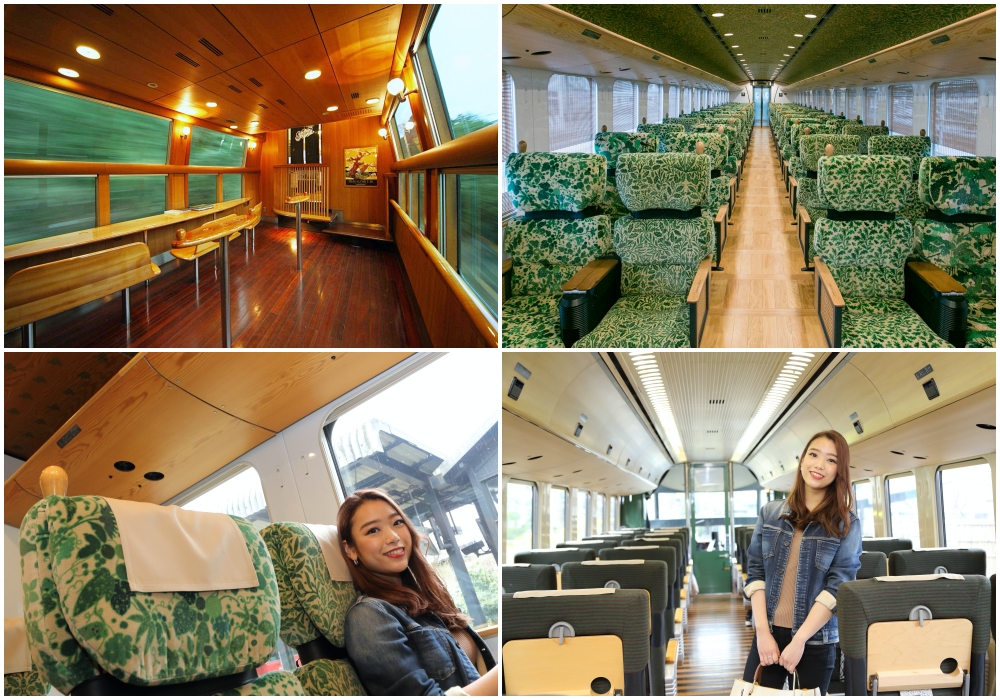
Elegant interior of the YUFUIN NO MORI. (Image credit: JR Kyushu)
Although the two vehicles have slightly different interiors, they both have a chic and modern design, with lush green seat fabric patterns that reflect the train’s name: “YUFUIN NO MORI” literally means “Forest of Yufuin”. The Generation I vehicle has a beautiful wooden free space area with floor-to-ceiling windows and window-facing seats, which passengers can make use of to enjoy the passing scenery. The Generation III vehicle has boxed seats, which groups of 3–4 pax can better enjoy conversations in.
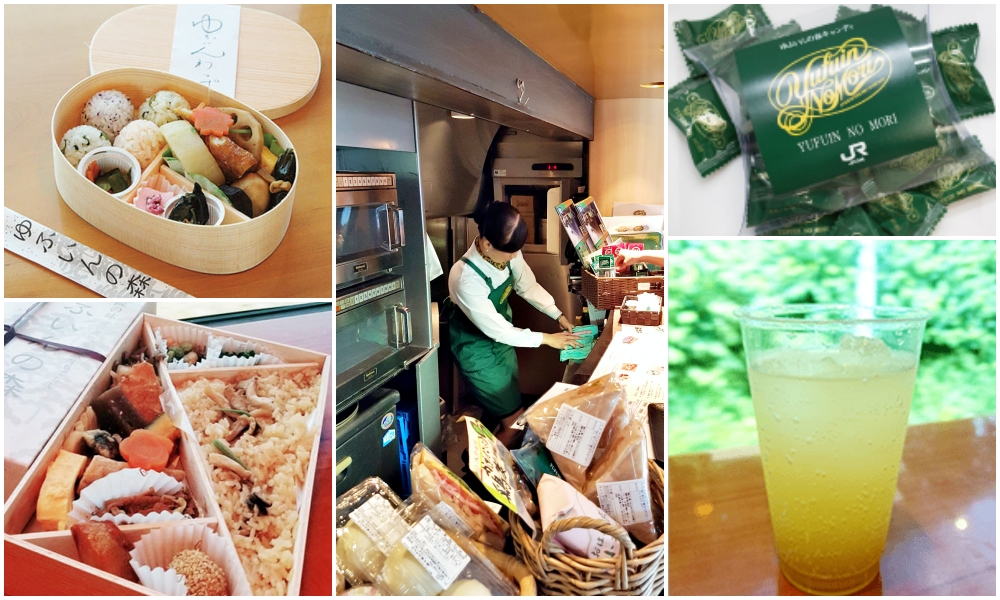
Grab a bit to eat or something to drink. (Image credit: JR Kyushu and Carissa Loh)
The journey from Hakata Station to Yufuin Station takes about 2 hours and 15 minutes, which is perfect to grab a bite to eat or a refreshing beverage to quench your thirst. YUFUIN NO MORI has 4–5 cars, so one tip is to head to the sales counter as soon as you can, because a queue is sure to form!
Bento lunchboxes require advanced reservations, which can be booked 1 month to 2 business days before departure (reservations can only be made by phone, and only in Japanese). If you didn’t manage to make a bento reservation, you can still choose from an assortment of light bites like sausages, chicken, cookies, ice cream, and more.
For beverages, we highly recommend the Yuzu Honey Squash (ゆずみつスカッシュ yuzu mitsu sukasshu), a delightful drink made from yuzu and honey from Hita City. It is the perfect combination of sweet and sour, and tastes very refreshing!

Get some souvenirs on the YUFUIN NO MORI. (Image credit: JR Kyushu and Carissa Loh)
Before you depart, how about getting something to commemorate your ride? All passengers will receive a commemorative postcard, so don’t forget to stamp it with the special stamp that’s only available on the train. There are also YUFUIN NO MORI-themed merchandise on sale, such as towels, key chains, A4 files, furoshiki cloths, toy train models, and more. If you are travelling with little ones, there is even a photo corner where children can try on a conductor’s uniform and hat, and take a commemorative photo.
Yufuin Station

Take a dip in the footbath at Yufuin Station. (Image credit: JR Kyushu)
Most travellers riding the YUFUIN NO MORI will probably take it to or from Yufuin Station. Something special about this station is the footbath (足湯 ashiyu), which is located right on the train station platform! Taking a dip costs just ¥200, and tickets can be purchased from the ticket counter. The ticket comes with a small towel to dry your feet, which you can bring home as a souvenir. With such a convenient location, why not take a quick soak to rejuvenate your fatigue?
Yufuin Onsen

Open-air bath with a fantastic view of Mount Yufu. (Image credit: ツーリズムおおいた)
The hot spring town of Yufuin in Oita Prefecture is one of the most highly ranked and well-loved in Japan. It is located on a river basin, and surrounded by many beautiful mountains, in particular Mount Yufu. Yufuin is known for its open-air baths (露天風呂 rotenburo) which offer stunning views of Mount Yufu in the distance.
In addition to overnight guests, many of the hot spring resorts also accept daytime visitors. Along the town’s main street, you can find many shops, small art museums, trendy cafes, and delicious patisseries, which make Yufuin a wonderful place for both overnight stays and day trips.
Lake Kinrin
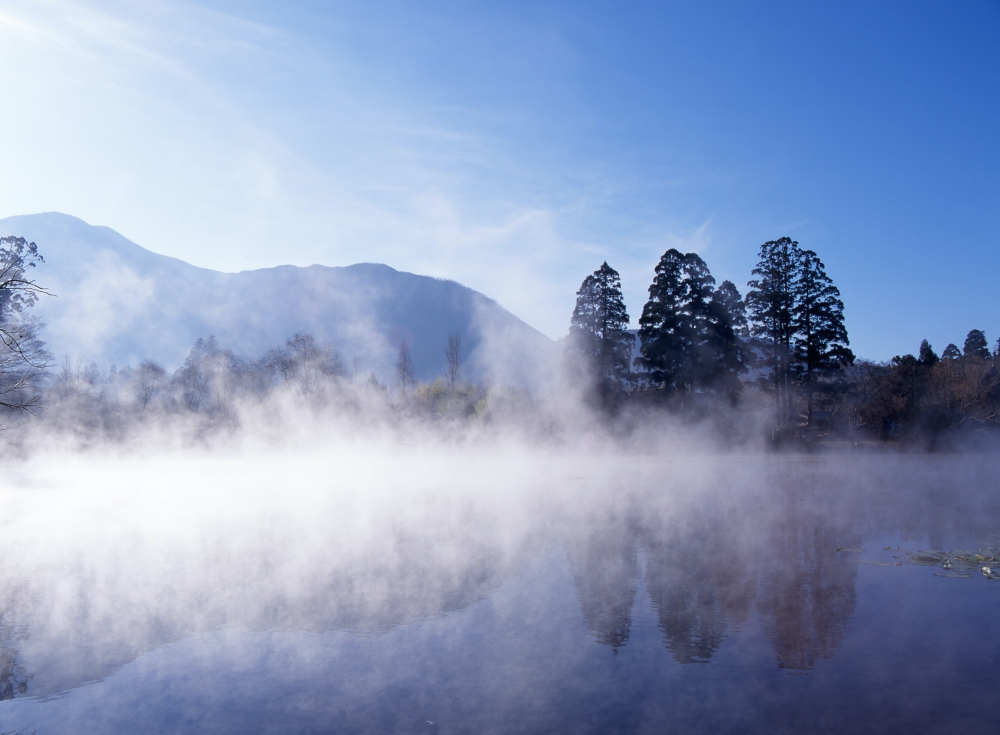
Lake Kinrin in the morning. (Image credit: ツーリズムおおいた)
One must-see spot while in Yufuin is Lake Kinrin (金鱗湖 Kinrinko), which is a 1.5km walk from Yufuin Station. Both cold water and hot spring water flow into the small lake, and if you come on cold days, especially in the mornings, you will be greeted with a beautiful sight of the lake covered with a mysterious mist, which is the hot spring water evaporating on the surface.
The name “Kinrin” means “golden scale”, and it is said that a Confucian scholar saw a fish in the lake, its scales gleaming a beautiful golden colour in the setting sun, and he thus named the lake after seeing this.
Take a virtual look inside the YUFUIN NO MORI. (Image credit: Google Maps and JR Kyushu)
The YUFUIN NO MORI makes 2–3 round trips per day of operation, and runs every day. You can check out this page for more information about the YUFUIN NO MORI’s schedule.
A one-way ride between Hakata Station and Yufuin Station takes around 2 hours 15 minutes and costs ¥5,190, but is free if you are using the All Kyushu Rail Pass or Northern Kyushu Rail Pass.
⑤ ASO BOY!: Fun for the whole family
Route: Kumamoto Station (熊本駅) ↔ Beppu Station (別府駅) on the Hōhi Main Line
Travelling with young children? If so, then the next train, ASO BOY! (あそぼーい!), is perfect for you. This train plies the Hōhi Main Line (豊肥本線) between Kumamoto Station (熊本駅) and Beppu Station (別府駅), and its name is a play on the word “asobō” (遊ぼう), which means “let’s play”, and Aso (阿蘇), the beautiful mountainous area that the train passes by.
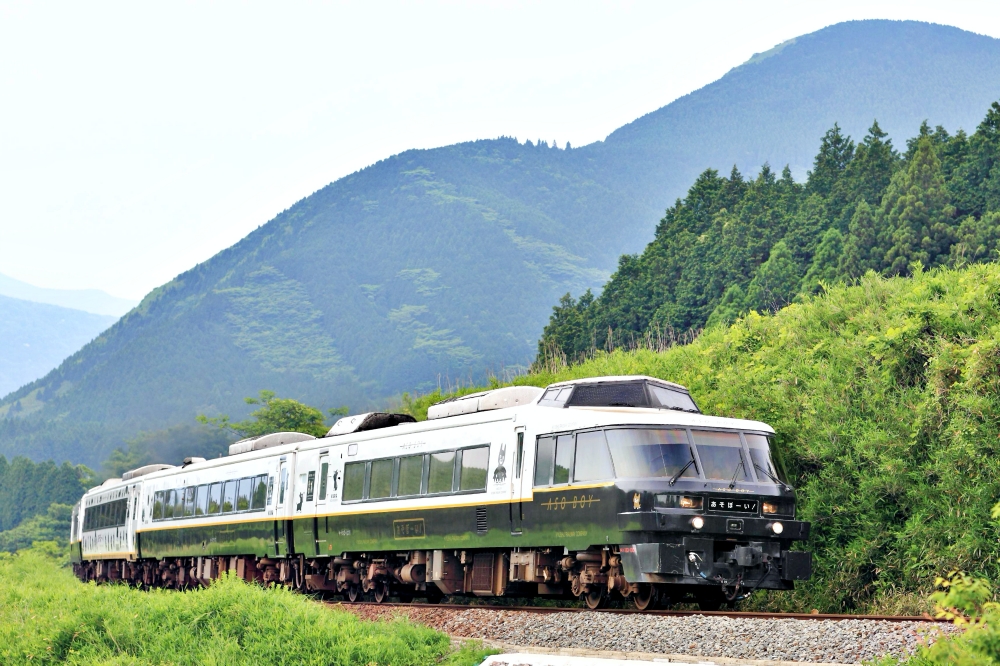
ASO BOY! (Image credit: JR Kyushu)
The Hōhi Main Line, which was badly damaged during the 2016 Kumamoto Earthquake, was fully restored in August last year, and the ASO BOY! finally began running again, much to delight of passengers and local people, who had been waiting years for its return.

ASO BOY! has its own mascot, Kuro-chan. (Image credit: JR Kyushu)
Celebrating its 10th anniversary this year, the ASO BOY! was created with families in mind, and is meant to be a fun-filled train, like an amusement park, that invites both adults and children on an adventurous journey.
Did you know? ASO BOY! even has its own mascot, a cute black dog named Aso Kuroemon, affectionately known as Kuro-chan.

How many Kuro-chan can you spot? (Image credit: JR Kyushu)
Try and spot all the Kuro-chan designs scattered around the train, both inside and outside. How many do you think there are? You can find Kuro-chan in various styles and designs, at places like the wall, seats, windows, noren (curtains), picture frames, and more. On the exterior, you can find 101 Kuro-chan in various poses. For the interior, why don’t you try counting the next time you ride the ASO BOY!?

ASO BOY! has a fun and colourful interior (Image credit: JR Kyushu)
ASO BOY! has a total of four cars, and features a variety of colourful seats built in different configurations, including boxed seats, sofa seats, window-facing seats, regular forward-facing seats, and more. At both ends of the train, there are panoramic seats offering 180-degree views of the sky, the mountains, and the land, and you can enjoy an unobstructed view of Aso’s majestic nature.

Car 3 was built for families with children. (Image credit: JR Kyushu)
On board, there are many facilities to cater to children’s fun and comfort, such as a ball pit, book corner, and special seats. In Car 3, the Family Car (ファミリー車両), the unique wooden ball pit is definitely a highlight for the young ones. An attendant is always on duty to keep an eye out for and play with the children.
In this car, you can also find the specially designed white Kuro-chan seats, which are made for parent and child to sit together and enjoy the scenery from the window. The window seat in particular, was created for children.
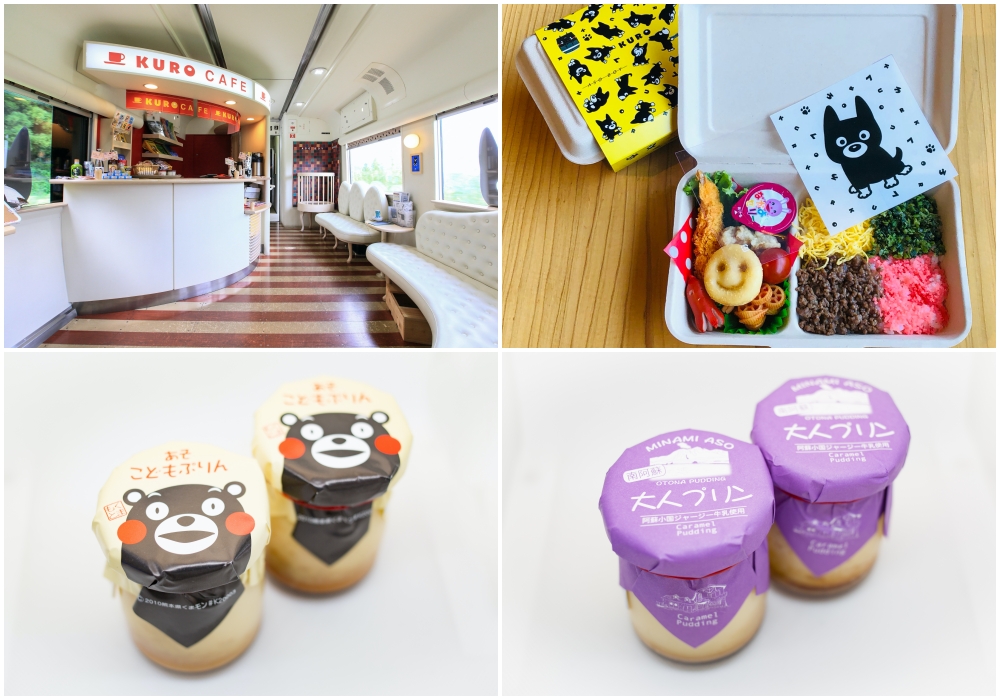
Grab a bit to eat on the ASO BOY! (Image credit: JR Kyushu)
If you’re hungry, head over to KURO CAFE in Car 3. Don’t miss the adorable Kuro-chan bento, which is a hit with kids. Available in limited quantities, the lunchbox features toriten (chicken tempura), and Koshihikari rice from Aso topped with four different coloured ingredients.
Another delicious treat you must try is the pudding, which come in child and adult versions. The child version is made with eggs and milk from Aso, while the adult version has fragrant rum for added depth of flavour.
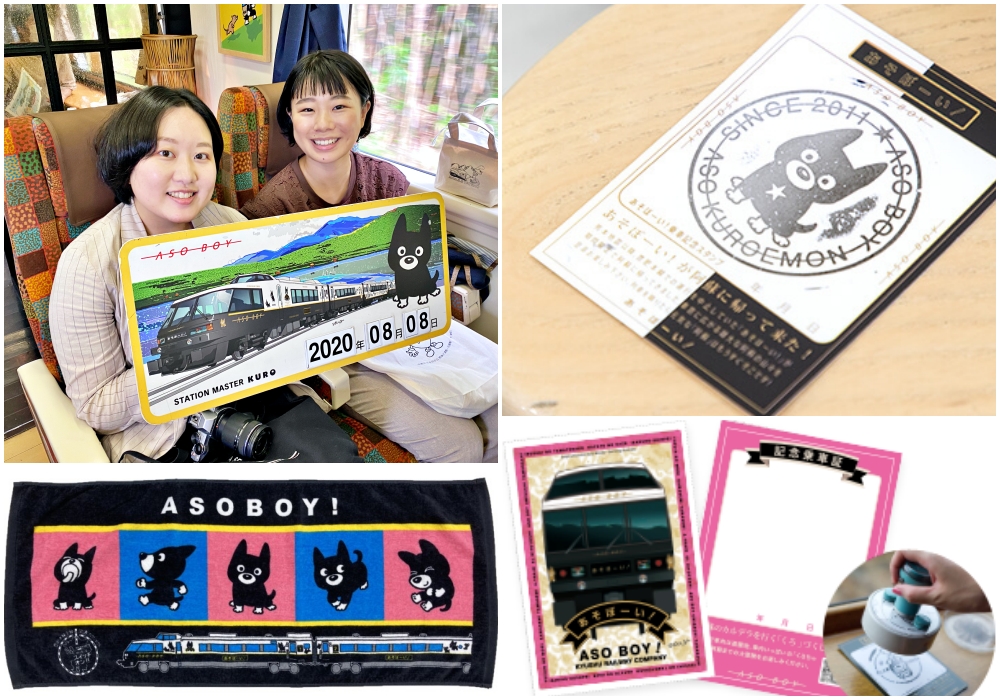
Don’t forget souvenirs for your trip on the ASO BOY! (Image credit: JR Kyushu)
Onboard, you can approach the friendly attendants help you take a commemorative photo with the photo board. All passengers will also receive a commemorative postcard, which you can stamp with the special stamp that’s only available on the train. You can also get your hands on limited edition Kuro-chan and ASO-BOY! themed merchandise like towels, tote bags, A4 files, mobile phone straps, and more.
One Piece Kumamoto Revival Project
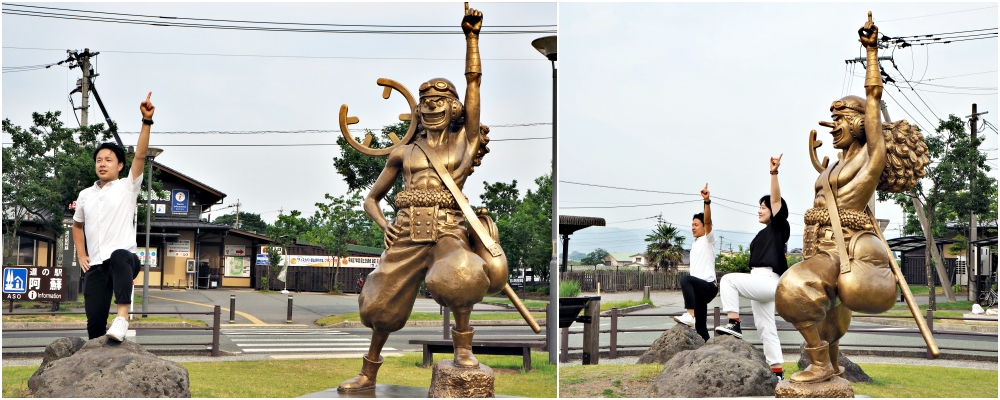
Usopp statue outside Aso Station. (Image credit: JR Kyushu)
Are you a fan of One Piece, the long-running, popular manga and anime? Did you know that its creator, Oda Eiichiro, was born in Kumamoto Prefecture? After the 2016 Kumamoto Earthquake, which devastated much of the prefecture, Mr Oda collaborated with Kumamoto Prefecture for tourism recovery efforts, and the One Piece Kumamoto Revival Project was hatched. As part of this project, statues of popular One Piece characters (the Straw Hat crew) were erected around Kumamoto Prefecture. Outside Aso Station (阿蘇駅), there is one of Usopp! If you have time, why not strike a pose and take a photo with him before you go?
Mount Aso Nakadake Crater

Nakadake Crater at Mount Aso. (Image credit: JR Kyushu)
While in Aso, a must-visit is definitely the majestic Mount Aso’s Nakadake Crater. Located in Aso-Kuju National Park, Mount Aso (阿蘇山 Aso-san) is the largest active volcano in Japan, and is also the most active volcano in Japan. Its caldera is one of the largest in the world, and in the centre, you can find five mountains.
Of the five, the most spectacular sight is perhaps Nakadake Crater (中岳火口 Nakadake-kakō), which is a magnificent sight to behold when you see the white smoke emitted up close and feel the raw power of the earth. The crater is accessible to the public, but access may be restricted when volcanic activity is high, when weather conditions are bad, or when there are high levels of poisonous volcanic gases.
To reach Nakadake Crater, take a 40-minute bus ride from JR Aso Station to Asosan Nishi Station/Aso Sanjo Terminal, then transfer to a 5-minute shuttle bus to the crater.
Take a virtual look inside the ASO BOY!. (Image credit: Google Maps and JR Kyushu)
The ASO BOY! makes 1 round trip per day of operation, and runs mostly on weekends and Japanese public holidays. You can check out this page for more information about the ASO BOY!’s schedule.
A one-way ride between Kumamoto Station and Aso Station takes around 80 minutes and costs ¥2,410, while a one-way ride between Beppu Station and Aso Station takes around 2 hours and costs ¥3,950, but rides are free if you are using the All Kyushu Rail Pass, Northern Kyushu Rail Pass, or Southern Kyushu Rail Pass.
⑥ KAWASEMI YAMASEMI: Enjoy the beauty of the mountains and the river
Route: Hakata Station (博多駅) ↔ Mojikо̄ Station (門司港駅) on the Kagoshima Line
*Heavy rain in July 2020 badly damaged the Hisatsu Line, hence the KAWASEMI YAMASEMI is operating in the above section instead.
The final train we’ll be introducing is the KAWASEMI YAMASEMI (かわせみやませみ), which is one of the newest D&S Trains, having made its debut in 2017. KAWASEMI YAMASEMI was built in the image of the beautiful rivers and mountains of the Kuma (球磨) region, and is a beautiful train named after wild birds that roam the rich nature.
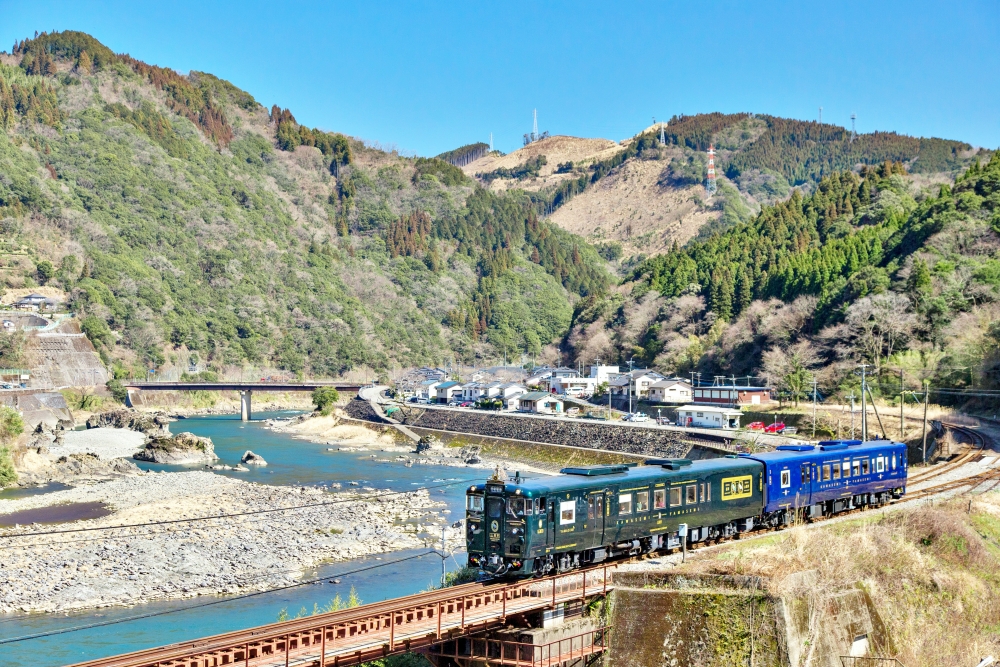
KAWASEMI YAMASEMI. (Image credit: JR Kyushu)
Surrounded by deep mountains on all sides, the Kuma area, where the scenic Kuma River flows, is where the KAWASEMI YAMASEMI draws its inspiration from. “Kawasemi” means “kingfisher”, while “Yamasemi” means “crested kingfisher”, and these two birds likely flew freely over Kuma even before humans settled there.
Did you know? KAWASEMI YAMASEMI originally ran in Kuma, on the Hisatsu Line (肥薩線) between Kumamoto Station (熊本駅) and Hitoyoshi Station (人吉駅). Unfortunately, heavy rain in 2020 damaged a section of the track, so currently the train runs between Hakata Station (博多駅) and Mojiko Station (門司港駅). However, the train’s concept remains unchanged, and aims to promote the rich nature and beauty of Kuma and Hitoyoshi.
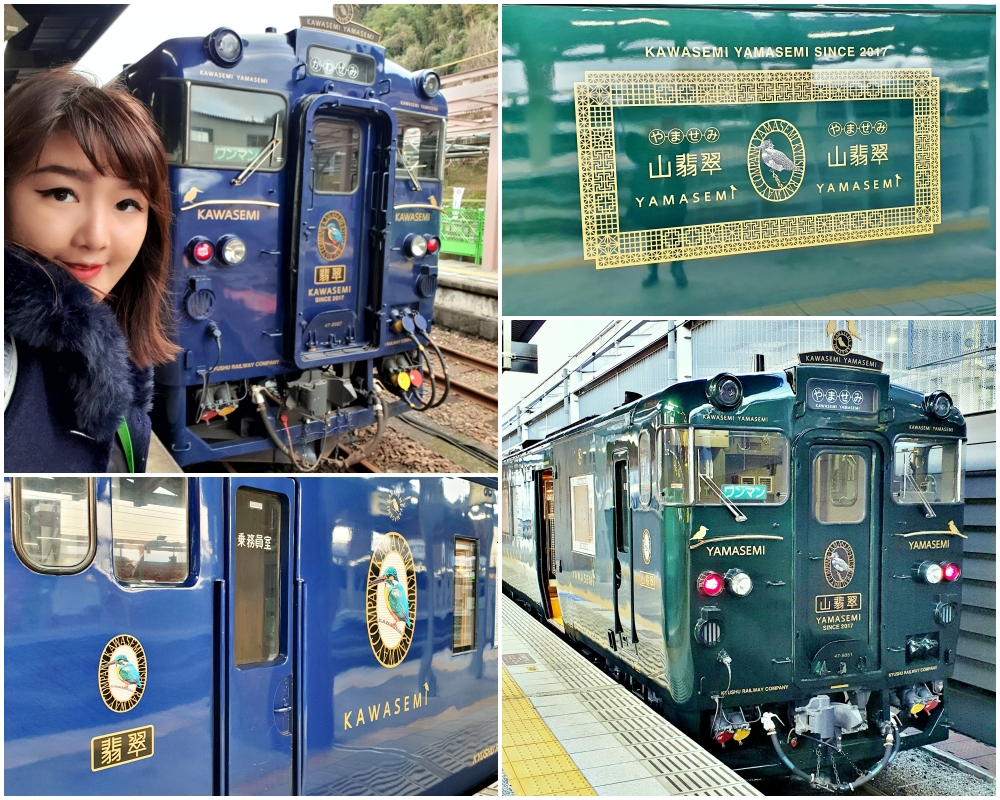
Blue and green exteriors of the KAWASEMI YAMASEMI. (Image credit: Carissa Loh)
KAWASEMI YAMASEMI is a contemporary Japanese train made up of two cars, one blue (KAWASEMI) and one green (YAMASEMI). These elegant, jade-like colours were chosen to reflect the dazzling blue of the Kuma River and the lush greenery of the mountains in the region. If you look closely, you will also notice that each car has images of the two birds.
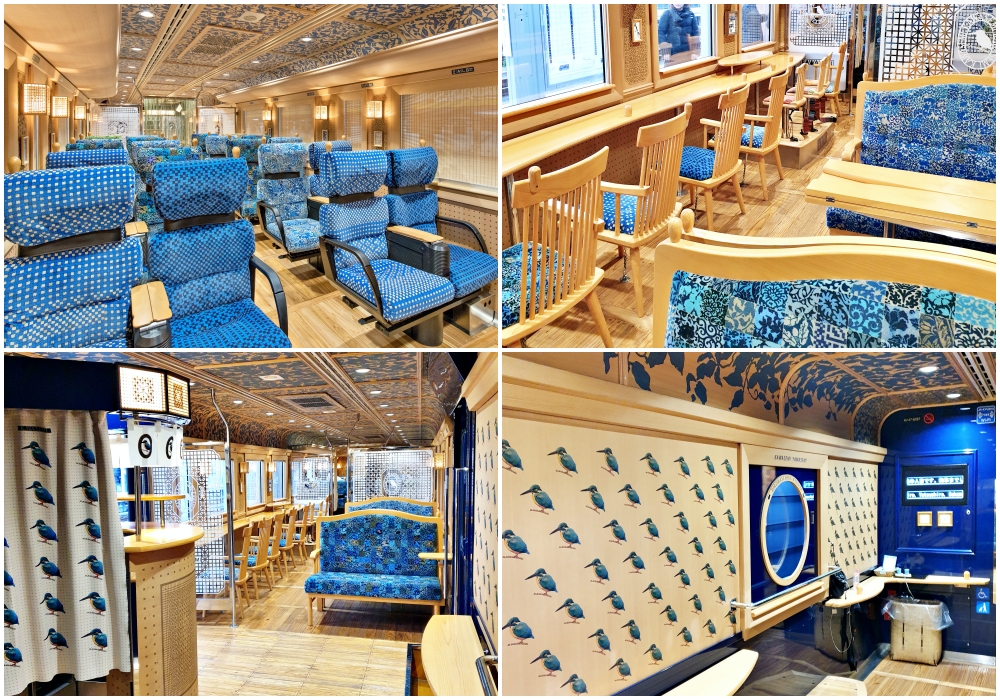
Inside the KAWASEMI car. (Image credit: JR Kyushu and Carissa Loh)
The stylish interiors of each car are also in theme, with different shades of blue decorating the KAWASEMI car. Various seat configurations, including seats with tables and window-facing seats, are available. One thing unique about the KAWASEMI car is that it even has a birdwatching corner, complete with a large round window and a pair of binoculars!

Inside the YAMASEMI car. (Image credit: JR Kyushu)
The YAMASEMI car, on the other hand, is decorated with chic green patterns that evoke the image of a forest. Locally grown cedar wood from Kuma is used to make the floors, while cypress is used to make the tables and counters. In this car, there is a showcase corner that displays famous local products from Yashiro, Kuma, and Hitoyoshi, such as shochu (焼酎), a type of Japanese distilled liquor.

Service and souvenirs. (Image credit: JR Kyushu)
Speaking of shochu, the service counter in the KAWASEMI car sometimes holds shochu-tasting events and other events introducing local products from Kuma and Hitoyoshi. If you’re craving a bite to eat or something to drink, you can check out the service corner in the YAMASEMI car, which sells a variety of snacks and souvenirs, like local shochu from Kuma, or local tea.
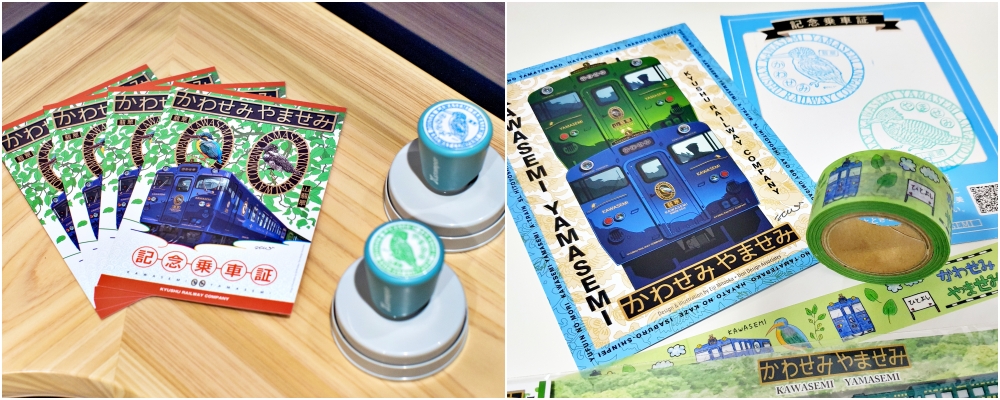
Commemorative postcards. (Image credit: JR Kyushu and Carissa Loh)
The KAWASEMI YAMASEMI has 1 round trips per day of operation, and runs mostly on weekends and Japanese public holidays. You can check out this page for more information about the KAWASEMI YAMASEMI’s schedule.
A one-way ride between Hakata Station and Mojiko Station takes around 90 minutes and costs ¥2,630, but is free are using the All Kyushu Rail Pass or Northern Kyushu Rail Pass.
Getting there
Which of these scenic train ridess would you be interested to take a trip on? All of them are free to ride with a JR Kyushu Rail Pass, so hop aboard for a fun-tastic ride the next time you are in Kyushu. In case you missed it, check out Part 1 of this series, where we introduced three trains plying scenic seaside highland routes!
JR Kyushu Rail Pass
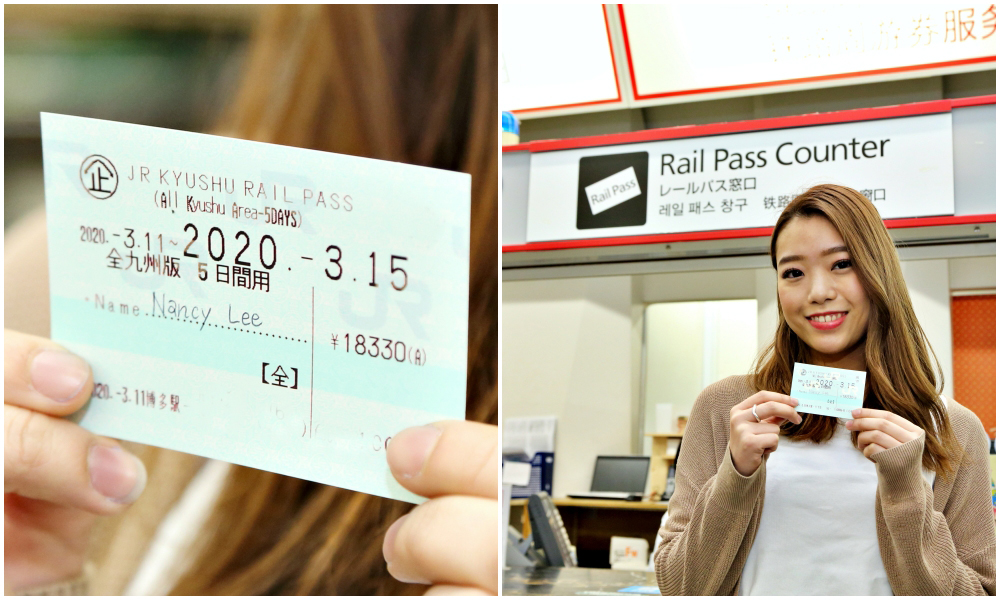
Travel around Kyushu with the All Kyushu Rail Pass. (Image credit: JR Kyushu)
If you are visiting Kyushu, check out the All Kyushu Rail Pass, an affordable pass offering unlimited rail travel on JR Kyushu lines (including bullet trains) in the valid area. There are three durations of rail passes—3-day, 5-day, 7-day—and the prices range from ¥20,000 to ¥25,000. The pass covers all three trains introduced in this article.
If you are mainly visiting the northern Kyushu area (Fukuoka, Oita, Kumamoto, Nagasaki, Saga), you can opt for the Northern Kyushu Rail Pass, which is available in 3-day (¥12,000) or 5-day (¥15,000) versions. The pass covers all three trains introduced in this article.
If you are mainly visiting the southern Kyushu area (Oita, Kumamoto, Miyazaki, Kagoshima), you can opt for the Southern Kyushu Rail Pass, a 3-day pass that costs ¥10,000. The pass covers ASO BOY!, but not YUFUIN NO MORI or KAWASEMI YAMASEMI.
The All Kyushu Rail Pass, Northern Kyushu Rail Pass, and Southern Kyushu Rail pass can be used for automatic ticket gates.
Header image credit: JR Kyushu




